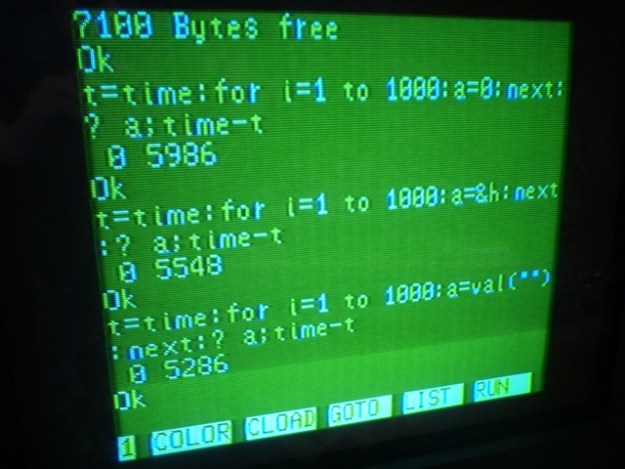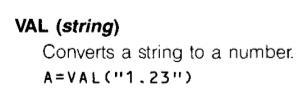The prolific Jim Gerrie has ported the original scaling demo over to the MC-10 and optimized it. On his system, it reports 9.5 seconds!
He shared his code to his github page, but I’ll include it here for commentary:
0 REM scale.bas 1 GOSUB100:TM=TIMER:FORZ=1TO M:CLS:A$=STRING$(W,C):FORA=(8-INT(HB))L+E-INT(WB)TOHL STEPL:PRINT@A,A$:NEXT:IFH<1ORH>=&H10 THENQ=-Q:R=-R 2 W=W+Q:H=H+R:NEXT 3 REM 60=NTSC 50=PAL 4 T=TIMER:PRINT:PRINT (T-TM)/60;"SECONDS" 5 END 100 DIMW,H,A$,A,B,L,Q,R,C,E,M,Z 110 I=32/4:REM SCALE WIDTH 120 J=16/3:REM SCALE HEIGHT 130 D=.1:REM SCALE INC/DEC 140 S=.5:REM SCALE FACTOR 150 W=IS:H=JS 160 Q=ID:R=JD 170 L=32:M=&H64 180 B=1/2:C=&HAF:E=15 190 RETURN
Not prepared to let an MC-10 beat a CoCo, I wanted to try it myself on my test system, the Xroar emulator.
I did. And I got 10.75 seconds! The CoCo is slower than the MC-10?
But that’s still faster than our previous best attempt of 13.3 seconds by Xroar author Ciaran Anscomb. Maybe I can speed the CoCo up a bit. Someone commented that DISK BASIC was slightly slower due to hooking in to an interrupt (I think it uses that for a time delay when turning off the drive motor after disk access). Since the MC-10 doesn’t have DISK anyway, I thought I’d disable RS-DOS and try it again.
11.78 seconds without Disk BASIC. IT got even slower? That’s odd. I tried this last night on the Mac Xroar emulator and thought it was slightly faster.
We have seen variances between emulators and systems when it comes to timing, so at some point we need to find a better way to do this. I mean, the MC-10 can’t be faster, can it?
Speaking of the MC-10, first, you should be aware that JIm Gerrie is one of the most prolific programmers around, porting and writing software on what seems to be a daily basis. Just check out his YouTube channel sometime. He has an incredible version of the Rally-X arcade game, entirely in BASIC.
But I digress.
I want to point out that Jim normally wouldn’t have been able to run my scaling demo on an MC-10 since it does not include a TIMER function, nor does it support HEX numbers (as far as I know?). He is using MCX BASIC by Darren Atkinson. Darren is the designer behind the CoCoSDC floppy disk replacement project. MCX-BASIC adds things like TIMER and HEX to the MC-10, making it closer to Extended Color BASIC on the CoCo.
But I digress again.
Adam
In the previous article, Adam shared the results of his version, and has now posted his code:
1 DIM SW,SH,SM,S,TM,Z,W,H,P 2 DIM A,B,C,D,E,F,L$ 3 SW=8:SH=5.33333334:SM=.1:S=.5 4 B=32:C=175:D=15:E=2:F=7 5 TM=TIMER 6 FORZ=1TO100 7 W=INT(SW*S):H=INT(SH*S) 8 P=D-INT(W/E)+(F-INT(H/E))*B 9 L$=STRING$(W,C) 10 CLS 11 FORA=1TO H:PRINT@P+A*B,L$:NEXT 12 S=S+SM 13 IF H<1 OR H>D THEN SM=-SM:S=S+(SM*E) 14 NEXT 15 PRINT:PRINT (TIMER-TM)/60;”SECONDS”
On my Xroar CoCo 2 test platform I get 17.93 seconds. Adam also sent in an interesting note which may explain some of the timing differences I am seeing reported:
This exercise also highlights the speed differences between a Coco2 and Coco3. I think the GIME chip is slower than the VDG in printing to the low-res screen. A Coco3 runs this code roughly 2 seconds slower!
Adam
Now that is an interesting observation. When I got my CoCo 3, my old machine went back in the box and I never had them both hooked up at the same time to do any comparisions.
I knew that the CoCo 3 40/80 column screens seemed slower. There are patches floating around that speed them up dramatically. Apparently it does some kind of MMU memory bank switch in and out for each character displayed. I did not realize there would be any difference in the 32 column VDG style screen. I’ll have to look into this and see if I can find out why.
Walter Zambotti
On the CoCo mailing list (if you use e-mail, and like the CoCo, you should sign up), Australian Walter Zambotti saw the original example and provided a tip:
Try changing the inner loop to remove all calculations like this
115 P2-P+32:H2=P*H+32:BK$=STRING$(W,175)
120 FOR A=P2 TO H2 STEP 32
130 PRINT @A,BK$
140 NEXT AI believe I chopped 7 seconds off the time.
Walter Zambotti via CoColist on March 13, 2020
It seems others picked up on this as well, as I have seen some speedy attempts that pre-calculate values (so the FOR/NEXT loop only has to increment by 32 to get to the next line for PRINT) and pre-render the string of blue blocks. (I was aware of strings being quite slow after my String Theory experiments, but some of the pre-calculated values I would not have thought of.)
Nice job, Walter!
Mission: Beat the MC-10
This leaves us with a problem. Jim Gerrie’s MC-10 version is still the fastest. Perhaps the 6800 in the MC-10 and it’s BASIC is just faster. Perhaps Jim’s just better at BASIC than we are. I’m willing to accept the second part, but my pride doesn’t want the first part to be true.
Can you make this faster than what Jim did? With the various attempts shared so far, perhaps bits and pieces of each of them could be combined to create something even faster?
Here is the original un-optimized code again for reference:
0 REM scale.bas 10 SW=32/4 ' SCALE WIDTH 20 SH=16/3 ' SCALE HEIGHT 30 SM=.1 ' SCALE INC/DEC 40 S=.5 ' SCALE FACTOR 70 TM=TIMER:FOR Z=1 TO 100 80 W=INT(SWS) 90 H=INT(SHS) 100 P=15-INT(W/2)+(7-INT(H/2))32 110 CLS 120 FOR A=1 TO H 130 PRINT@P+A32,STRING$(W,175) 140 NEXT A 150 S=S+SM 160 IF H<1 OR H>15 THEN SM=-SM:S=S+(SM*2) 170 NEXT Z 180 ' 60=NTSC 50=PAL 190 PRINT:PRINT (TIMER-TM)/60;"SECONDS"
If you don’t have access to a real CoCo or emulator, you could use one of these from a web browser:
Although there is a way to load code into them, I am not sure if there is a way to get the code back out. However, I have been typing my BASIC up in a text editor on my Mac. Xroar allows mounting a test file (with the extension of .bas or .asc) as a cassette tape, then doing a “CLOAD” to load it in as if it were a program saved to tape in ASCII format. This allows me to edit and make changes on my Mac, then load the results into Xroar for testing.
If you try Xroar Online, set the “Machine:” type to “Tandy CoCo (NTSC)” to match the timing of the emulated Amercian CoCo I am using (where TIMER is 60 tickts per second, versus the PAL version that is 50 per second). Then, save out the code as a text file and mount it using the “Tape:” insert option. You can then type CLOAD in the emulator to load and RUN it.

Any takers?
Until next time…

































